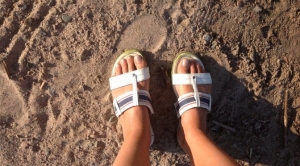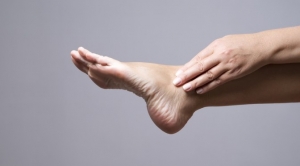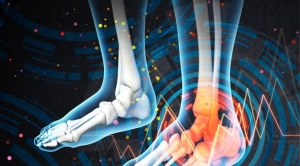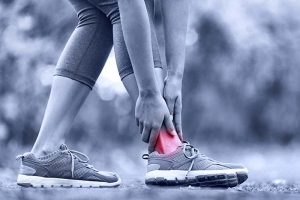Connect With Us
Blogs
Displaying items by tag: Foot Doctor
15 Steps to Fabulous Summer Feet
Summer can be hard on your feet, making proper foot protection a priority. Here are 15 simple steps to healthy, beautiful feet all year round:
Use Sunscreen
Protect your feet the from harsh UV rays on sunny summer days. Apply sunscreen with SPF 15 or higher to protect your skin from cancer and premature aging. Also, remember to reapply your sunscreen after swimming or sweating, even if the sunscreen claims to be waterproof.
Avoid Walking Barefoot
Walking barefoot is always dangerous, but the intense summer heat increases your risk of sustaining foot injuries. It also puts you at risk of developing plantar warts, ringworm, athlete’s foot, and other infections on the soles of your feet.
Wash Feet
Wash your feet with warm water after wading in lakes, ponds, and other stagnant bodies of water. Still water breeds bacteria, leaving you vulnerable to infection.
Treat Yourself to a Pedicure
Treating yourself to regular pedicures will ensure that both your nails and feet look their best in your chic summer styles.
Stay Hydrated
Staying properly hydrated during the hot summer months will prevent swollen feet. Proper hydration also improves your circulation, which in turn helps you fight infection.
Moisturize
Your feet are drier in the summer since you’re no longer wearing socks. Apply plenty of moisturizer in the morning after your shower to lock-in the moisture. For the best results, reapply before bed.
Wear The Right Socks
Acrylic and synthetic blend socks like CoolMax work the best to wick perspiration, preventing fungal infection. Socks that do not wick perspiration, such as those made from 100% cotton, increase your risk of developing blisters.
Prevent Blisters
Sandals can often cause blisters when they rub against bare feet. If you feel a blister developing, use extra padding such as liquid bandages to protect the affected area. If a blister does develop, be sure to treat it with antibiotic ointment after it pops.
Keep Shoes and Socks Dry
If your shoes or socks get wet, remove them. Wearing wet footwear leaves you vulnerable to developing fungal infections and blisters. Always bring a spare pair of socks and shoes if your feet could potentially get soaked.
The Right Shoes for The Right Occasion
Whether you’re going camping, hiking, boating, or running, it’s always best to wear footwear designed for the activity. Wearing improper footwear during strenuous activity can result in serious injury.
Air Out Feet
Avoid wearing closed-toe shoes and reach for sandals to let your feet breathe. If closed-toe shoes are required, be sure to take them off periodically in order to keep your feet from sweating.
Evaluate Your Flip-Flops
Flip-flops tend to cause sore feet, but that doesn’t mean that you have to avoid them. Be sure to choose flip-flops with extra padding, and avoid walking long distances in them.
Add Cushioning to Shoes.
Many summer shoes do not provide the proper cushioning to keep your feet protected and pain-free. Due to this, you should replace the cushioning in your shoes whenever possible. There are many over-the-counter insoles that will add extra cushioning on the cheap.
Inspect Old Shoes.
Old, worn-out shoes can cause blisters and other foot injuries. Be sure to assess the condition of your summer shoes, and throw away any questionable pairs.
Fore more foot care tips and inspiration, contact the experts at Superior Foot & Ankle Care Center for all of your podiatric needs.
Pregnancy and Painful Feet: Tips and Tricks for Expecting Mothers
Expecting mothers often experience swollen legs, feet, and ankles during and immediately after their pregnancies. This is due to the extra weight and stress on the feet, which causes pain after long periods of walking or standing.
For some mothers the extra weight on their feet may even cause their arches to fall, causing extreme pain. When the arches of your feet fall, you may begin to over-pronate, or turn in abnormally when walking. Over-pronation can stretch the plantar fascia, which is the tissue lining the bottom of the feet, causing a painful inflammation known as plantar fasciitis.
Edema, or swollen feet, is another common issue that expecting mothers face.
Both of these foot issues, especially when experienced together, make it extremely difficult to walk or stand for a long time. Therefore, it is vital for expecting mothers with pre-existing foot issues to discuss how their pregnancy will affect their feet with a podiatrist.
Below are a few tips for mothers to treat swollen and aching feet:
Always wear comfortable and supportive footwear
For added comfort and support, try using gel insoles.
Exercise regularly
The more you move, the more blood moves out of your legs into the rest of your body. If you find most exercise painful, try using a stationary bike or an elliptical trainer.
Drink plenty of water; avoid salt and caffeine
Staying properly hydrated helps your body flush its system of extra fluids. Therefore, drinking lots of water will help you relieve your swollen feet and ankles. Avoid consuming salt and caffeine because they cause your body to retain fluids.
Elevate and ice your feet
Elevating and icing your feet helps relieve the pain and tension associated with swollen feet and ankles.
Soak feet in warm water
Soaking your feet can relieve their pain and tension. In addition, the warm water can stimulate blood flow and reduce your swelling.
Get a foot massage
A massage is an excellent way to alleviate pain and reduce swelling. Massages stimulate blood flow and improve circulation, providing the muscles and tissues with the nourishment they need to heal. Improved circulation also reduces swelling.
Apply pain relief ointments
There are many over-the-counter pain relief ointments specially formulated for expecting mothers. These ointments help relieve pain and tension, especially from the bottoms of your feet. While these ointments are designed for pregnant women, it is best to speak to a healthcare professional before you begin using them.
Know your limits
If you find that your feet are becoming extraordinarily swollen after you walk, it is best to take breaks and to elevate your feet whenever possible.
Motherhood is beautiful, and your foot pain shouldn’t ruin the experience. Schedule a consultation with Dr. Vikki today for personalized foot care and relief.
What Causes Ingrown Toenails
Toenails that curve and dig into the skin of your toe are called ingrown toenails. Sometimes even the size of the nail are covered in skin and become embedded in the toe. This is why you should always be sure to cut your toenails straight across to discourage the sides from growing into your skin. Any toe can develop an ingrown toenail however, it is often the big toe.
While ingrown toenails are not often serious medical problems they can be severely painful. And, if left untreated and uncared for properly ingrown toenails can become infected. This is why it is important to receive proper treatment for your ingrown toenails right away.
What causes ingrown toenails?
- Shoes that are too small because they squeeze the toes.
- Toenails being cut too short.
- A toenail that has become damaged or chips can become an ingrown toenail.
- Having toes are too small to accommodate proper nail growth.
People with congenital conditions that cause them to have toenails that are frequently larger or smaller than normal should take care to always trim their nails properly and maintain proper foot hygiene because they are at high risk of developing ingrown toenails.
You may also develop ingrown toenails after sustaining a foot injury, such as a broken foot.
Other ways to keep your feet/toes healthy.
- Keep your feet clean and dry
- Keep your feet safe in public areas where they are susceptible to contracting diseases like athlete’s foot.
- Wear breathable footwear
- Don’t share footwear
- Always wear shoes that fit you properly
- If your toenails are discolored be sure to not apply any nail polish to them. Discoloration is often a sign of infection, and the Polish may make the infection worse.
Treatments
- Soak your feet
- Take over the counter pain medication
- Using a small nail file pulls the skin gently away from the nail
- Rub your toe with antibiotic ointment.
- Bandage your toes
When you develop ingrown toenails it is important to put any and all of these treatments into practice right away before you develop an infection.
If you suspect you have an infection or your ingrown toenails consistently come back, it is best to see a podiatrist as soon as possible. In addition to treating your ingrown toenail and possible infection, the podiatrist can give you a clear idea of what causes ingrown toenails which can help you avoid developing them in the future. If it persists, you may need a small surgical procedure to remove the ingrown sides of your toenail. People with diabetes should always be their podiatrist if they think they have an ingrown toenail as if they can lead to serious health complications.
Now that you know more about the causes and treatment for ingrown toenails be sure to get yours looked at by a foot care professional, especially if you suspect that you have an infection. If you have any further questions about ingrown toenails, don’t hesitate to contact us. To schedule an appointment, visit doctorvikki.com.
Bunions
A bunion is an enlargement of the base joint of the toe that connects to the foot, often formed from a bony growth or a patch of swollen tissues. It is caused by the inward shifting of the bones in the big toe, toward the other toes of the foot. This shift can cause a serious amount of pain and discomfort. The area around the big toe can become inflamed, red, and painful.
Bunions are most commonly formed in people who are already genetically predisposed to them or other kinds of bone displacements. Existing bunions can be worsened by wearing improperly fitting shoes. Trying to cram your feet into high heels or running or walking in a way that causes too much stress on the feet can exacerbate bunion development. High heels not only push the big toe inward, but shift one's body weight and center of gravity towards the edge of the feet and toes, expediting bone displacement.
A podiatrist knowledgeable in foot structure and biomechanics will be able to quickly diagnose bunions. Bunions must be distinguished from gout or arthritic conditions, so blood tests may be necessary. The podiatrist may order a radiological exam to provide an image of the bone structure. If the x-ray demonstrates an enlargement of the joint near the base of the toe and a shifting toward the smaller toes, this is indicative of a bunion.
Wearing wider shoes can reduce pressure on the bunion and minimize pain, and high heeled shoes should be eliminated for a period of time. This may be enough to eliminate the pain associated with bunions; however, if pain persists, anti-inflammatory drugs may be prescribed. Severe pain may require an injection of steroids near the bunion. Orthotics for shoes may be prescribed which, by altering the pressure on the foot, can be helpful in reducing pain. These do not correct the problem; but by eliminating the pain, they can provide relief.
For cases that do not respond to these methods of treatment, surgery can be done to reposition the toe. A surgeon may do this by taking out a section of bone or by rearranging the ligaments and tendons in the toe to help keep it properly aligned. It may be necessary even after surgery to wear more comfortable shoes that avoid placing pressure on the toe, as the big toe may move back to its former orientation toward the smaller toes.
When is Foot Surgery Necessary
In some cases, foot issues can be corrected through a number of treatment methods. However, if pain and discomfort when you run, stand or walk is consistent, then foot surgery is necessary. Foot surgery can correct your feet’s physical deformities and, therefore, alleviate any of the discomfort and pain that you are feeling. Here’s a list of common foot issues and deformities that require surgical removal to relieve pain.
Bunions
Bunions are a common foot deformity that is characterized by an enlargement of the bones and tissue around the big toe. Like most foot deformities bunions are hereditary. This enlarged area is prone to becoming swollen, inflamed and makes walking incredibly painful and difficult. When conservative care failed to alleviate these issues, it may be best to have them surgically corrected. Your foot care professional will be able to instruct you as to which surgical procedure will be best for you after running some tests and taking x-rays.
Hammertoes
Hammertoes are characterized by a curvature of the big toe, which often affects the tendons and nerves around it as well. Because of the buckling of the toes, footwear can cause an immense amount of pain and discomfort. I is not uncommon for those who suffer from hammertoes to also have a large number of corns and calluses on the affected area due to their deformity rubbing against their footwear. A surgical procedure can realign your toe bones and alleviate the pain and discomfort associated with hammertoes.
Bone Spurs
Bone spurs are overgrowths of bones that results in trauma and pressure to the tendons and ligaments. Pain and discomfort can also be associated with bone spurs depending upon where they are located. For example, if the bone spurs are located under your toenail this may cause a toenail deformity and making it difficult to walk and painful to wear shoes. What surgical procedure is needed to correct bone spurs depend on their size and location, so be sure to consult your Foot Care Professionals to decide which procedure is best for you.
Bunionette or Tailor’s Bunion
A Bunionette is protuberance of bone on the outside of the foot behind firth or smallest toe. Many factors can cause this issues such as heredity, the way you walk and trauma to name a few. They can become inflamed and swollen, particularly if they rub against your footwear. Much like bunions, if conservative care does not alleviate the pain and discomfort associated with this deformity, it may be best to have them surgically corrected.
Neuroma
Irritation of the nerves may cause them to become swollen and inflamed and result in an enlargement of a nerve segments, this is called Neuroma. This nerve segment is often found between the third and fourth toe and can be quite painful particularly when walking. People came develop Neuroma for a number of reasons to include wearing high heel shoes and having an abnormal bone structure. This deformity can cause pain and burning for particularly after walking for a long time. If this deformity has greatly impeded your quality of life, it’s best to speakers foot care professional about a surgical solution.
Now that you know a few examples of when foot surgery is absolutely necessary hopefully it helps you decide if surgery is the right choice for you. Remember foot pain is not normal and having healthy, pain-free feet are essential for living a well-rounded life. Our expert team would be happy to discuss any questions you may have about the procedure. To schedule a consultation visit doctorvikki.com.
Sports Related Foot And Ankle Injuries
Foot and ankle injuries are common among people who participate in sports. Several factors contribute to this. They include failing to stretch or warm up properly, not wearing the proper type of shoe and not taping or providing other types of support for the ankle or foot. The most common foot and ankle injuries suffered by people involved in sports are plantar fasciitis, ankle sprains and Achilles tendon damage or ruptures. If not treated properly, they can lead to permanent disability.
Treating these injuries is relatively simple if they are identified and addressed early. Many athletes dismiss the initial aches and pains associated with injury as just soreness or tired muscles. Their first response is usually to try to work through it. This can lead to serious problems. Many minor injuries are made far more serious when athletes continue to put strain and pressure on them. That attitude can change a mild strain into a serious strain and a minor tear into a rupture. Athletes should have unusual aches and pains evaluated by a skilled medical professional.
Plantar fasciitis is a painful injury. It is inflammation of the plantar fascia, the thick band of tissue running from the heel to the base of the toes. If left untreated, it can lead to a degenerative disease called plantar fasciosis. There are several effective treatments for this ailment. Doctors often prescribe rest, massages, stretching, night splints, physical therapy, anti-inflammatory medication, corticosteroids or surgery, usually in that order. The most effective treatment for plantar fasciitis is orthotics, which offers foot support. Surgery is occasionally used as a last resort, but it comes with the risk of nerve damage and infection and often does not stop the pain.
The Achilles tendon is the largest tendon in the body. It connects the calf muscles to the heel bone. Running, jumping and walking all impact this tendon. Two common injuries to the Achilles tendon are tendonitis and a rupture of the tendon. Tendonitis is inflammation in the tendon often caused by an increase in the amount of stress placed on it. Non-surgical treatments include rest, ice or anti-inflammatory medication. A rupture (tear) of the Achilles tendon can be treated by placing the lower leg in a cast for several weeks or with surgery. Many physicians feel surgery is the better option because it lowers the risk of re-ruptures. Both methods require 4 to 6 months of rehabilitation.
Ankle sprains are the most common sports related foot and ankle injury. A sprain occurs when the ligament holding the ankle bones and joint stretches beyond its normal range. It can be treated non-surgically with a combination of rest, ice wrapped around the joint for 30 minutes immediately after injury, compression by a bandage and elevating the ankle above the heart for 48 hours. This combination is referred to as RICE. Severe ankle sprains in which the ligaments are torn may require reconstructive surgery followed by rehabilitation.
What to Do to Keep Your Child’s Feet Healthy
Being a parent involves caring for your child in every way you can. You make sure they are eating the right food, being nice to others, and staying out of any trouble. However, it is also important that you are watchful of their health, more specifically their foot health. Maintaining good foot health in childhood is important in preventing later conditions in life from happening. As children continue to develop, their feet require different techniques of care. Here are some various ways in which you can help your child’s feet stay healthy.
A baby needs a lot of care and attention overall, but the importance of their feet should never be forgotten. Before a baby turns one, their feet change and develop greatly. It is important that during this time, a mother avoids putting tight socks on their child. She should also encourage movement of their feet so the baby can begin to feel more comfortable using them.
As a baby enters the toddler years of his or her life, they are begin to walk around. When your baby begins to take those first steps, it is crucial that they are wearing protective shoes on their feet. As a mother that is observant of your child’s feet, you may notice changes in them. This is completely normal as the feet are becoming susceptible to the activity of walking. It is normal for a toddler to be a bit unsteady or to “walk funny” at first.
When your child grows out of their toddler years, it is important that you begin to show him or her how to care for their feet on their own. Practice with your child proper hygiene in order to prevent foot fungus or infection. Since children are constantly on the move, it is crucial to be cautious of any accidents or injuries that might occur. If an injury occurs, it is advised that you take your child to be examined by a doctor immediately. Since your child is still growing, particular injuries can shift the way in which a bone or other important part of the foot is developing.
Babies and kids are always changing and growing. Your job as a parent is to make sure they stay healthy and making sure they are properly maintained. This involves proper foot care and making sure the feet stay healthy. Following this guide, your child can live a long and happy life.
Making Sure Your Ankle Heals Properly After Injury
If you have sustained a sprain or a fracture to your ankle, it is important to let it heal properly in order to avoid permanent damage. Ankle sprains are incredibly common: over 25,000 people suffer them every day. A sprain occurs when one or more ligaments on the outside of your ankle are pulled or torn. As it is hard to differentiate a sprain from a fracture, it is imperative to seek medical attention so that your ankle can be x-rayed. Once your injury has been diagnosed, you’ll be able to give it the care it needs in order for it to heal properly. Here are some tips for properly caring for your ankle injury to ensure that it heals correctly:
For a Sprain
Depending upon how serious the sprain is, the sprain can be classified as grade 1, 2, or 3. The best way to treat a sprain is to utilize the R.I.C.E. method: rest, ice, compression, and elevation. For a grade 1 sprain, you should rest your ankle by not walking on it as much as possible, only putting minimal weight on it. In many cases, an ankle brace will be given in order to help reduce the swelling and discomfort of a sprain, which may make it easier to put some weight on it if need be. However, if it is too difficult to bear weight, you may be given crutches. You can apply ice to help relieve the pain and swelling. When you ice your ankle, make sure that there is a barrier between the ice and your skin, such as a pillowcase or a towel. You shouldn’t ice your ankle for more than 20 minutes in order to avoid frostbite. Compression can help control the swelling, as well as provide your ankle with some support. Finally, you should elevate your ankle as much as possible by reclining and propping it up. It’s best to elevate your ankle either above your waist or your heart for optimal recovery.
With a grade 2 sprain, you would follow the same steps. While the grade 1 may take a week to heal, a grade 2 may take up to a month. Grade 3 sprains are rare and may require casting or surgery.
For a Fracture
If you fracture your ankle, your treatment will involve casting, taping, wrapping, or booting, depending upon the type and severity of the fracture. Much like a sprain, it is important to rest and elevate a fractured ankle. A fracture usually takes 4 to 8 weeks to heal. Once the cast comes off, you may have to follow the R.I.C.E. method until you regain strength in your ankle.
Rehabilitating Your Ankle
If you have a sprained or fractured ankle, you need to properly rehabilitate it in order to regain your full strength and flexibility. The first phase of rehabilitation is the R.I.C.E. method. The second phase is helping your ankle regain flexibility, strength, and range of motion by walking and putting weight on it. The last phase is exercising your ankle in order to strengthen the muscles and ligaments further.
Be sure to follow these steps to help your ankle heal properly. If you have any questions or concerns about your ankle injury, contact us today to schedule an appointment.
Plantar Fasciitis
The plantar fascia is a connective tissue in the heel that stretches across the bottom length of your foot. Plantar fasciitis occurs when the connective tissue becomes inflamed, causing heel pain and discomfort during physical activity. Although the condition is completely treatable, traditional methods can take up to a year to start becoming effective.
Plantar fasciitis is caused by a number of everyday activities, so understanding the condition is important for managing and treating it. One of the most common causes of plantar fasciitis is excessive running, especially with improper fitting or non-supportive shoes. Too much exercise can lead to the plantar fascia being overworked and overstretched, which can cause tears in the tissue. Along with improper fitting shoes, pronation, the rolling of the feet inward, is a common cause of plantar fasciitis. If not treated properly, the plantar fascia becomes overstretched and starts to tear, causing inflammation.
Despite the common causes of plantar fasciitis, there are many different treatment options. For less severe cases, conservative home remedies include taking anti-inflammatory drugs to alleviate pain, applying ice packs to the bottom of your foot and heel, slowly stretching and exercising your feet to re-strengthen the tissue, and using orthotic devices are all ways to help manage your plantar fasciitis.
For more severe cases, shockwave therapy has become a common solution for plantar fasciitis. Shockwave therapy can effectively break up the tissue on the bottom of your foot which facilitates healing and regeneration. This fights the chronic pain caused by plantar fasciitis. Even if this doesn’t work, surgery is always a final option. Surgery on the tissue itself can be done to permanently correct the issue and stop the inflammation and pain in your heels.
No matter what the case may be, consulting your podiatrist is the first and best step to recovery. Even the slightest amount of heel pain could be the first stage of plantar fasciitis. Untreated symptoms can lead to the tearing and overstretching of tissue. Because the tearing of tissue can be compounded if it remains ignored, it can evolve into a severe case. The solution is early detection and early treatment. Talk to your podiatrist about the possibilities of plantar fasciitis if you’re experiencing heel pain.
Everything You Need to Know About Gout
Gout, typically found in diabetic patients, is an unusually painful form of arthritis caused by elevated levels of uric acid in the bloodstream. The condition typically strikes the big joint on the big toe. It has also been known to strike the knees, elbows, fingers, ankles and wrists—generally anywhere that has a functioning, moving joint.
The high level of uric acid in a person’s bloodstream creates the condition known as hyperuricema—the main cause of gout. Genetic predisposition occurs in nine out of ten sufferers. The children of parents who suffer gout will have a two in ten chance of developing the condition as well.
This form of arthritis, being particularly painful, is the leftover uric acid crystallizing in the blood stream. The crystallized uric acid then travels to the space between joints where they rub, causing friction when the patient moves. Symptoms include: pain, redness, swelling, and inflammation. Additional side effects may include fatigue and fever, although reports of these effects are very rare. Some patients have reported that pain may intensify when the temperature drops, such as when you sleep.
Most cases of gout are easily diagnosed by a podiatrist’s assessment of the various symptoms. Defined tests can also be performed. A blood test to detect elevated levels of uric acid is often used as well as an x-ray to diagnose visible and chronic gout.
Treatment for gout simply means eliminating symptoms. Non-steroid anti-inflammatory drugs or NSAIDs (Colchicine and other corticosteroid drugs, etc.) will quell the redness, the swelling, and the inflammation. However, managing your diet, lifestyle changes, and using preventative drugs are all helpful toward fully combating the most severe cases.
Those that lead an inactive lifestyle are at a higher risk for gout. Any amount of exercise decreases the probability of repeat encounters with the condition. Reducing your consumption of red meat, sea food, and fructose-sweetened drinks also reduces the likelihood of chronic gout as well.
Ingesting Vitamin C, coffee, and particular dairy products can help with maintaining a healthy lifestyle. There are new drugs out on the market that inhibit the body’s production of uric acid-producing enzymes. However, reducing or eliminating your overall levels of uric acid is the best remedy to ensuring you lead a gout-free life.





